Working with chat rooms¶
Overview¶
Web Call Server allows embedding of a video chat to your project, that will work on most of modern browsers without installing third-party software as well as on mobile devices.
Supported platforms and browsers¶
| Chrome | Firefox | Safari | Edge | |
|---|---|---|---|---|
| Windows | ✅ | ✅ | ❌ | ✅ |
| Mac OS | ✅ | ✅ | ✅ | ✅ |
| Android | ✅ | ✅ | ❌ | ✅ |
| iOS | ✅ | ✅ | ✅ | ✅ |
Supported codecs¶
- Video: H.264, VP8
- Audio: Opus, G.711
Functions¶
- Video chat
- Text chat
- Video conference
- Video conference with screen sharing
Operation flowchart¶

- The browser of the participant 1 connects to the server via Websocket and sends the
joincommand. - The browser of the participant 1 can send a stream via WebRTC to publish it in the chat room and receive streams published in the room.
- The browser of the participant 2 connects to the server using Flash and sends the
joincommand. - The browser of the participant 2 can send a stream via RTMP to publish it in the chat room and receive streams published in the room.
Quick testing¶
Video conference testing¶
- For the test we use:
- the demo server at
demo.flashphoner.com -
the Conference web application to arrange a video conference.
-
Open the Conference web application. In the
Loginfield enter any arbitrary user name, for exampletest:
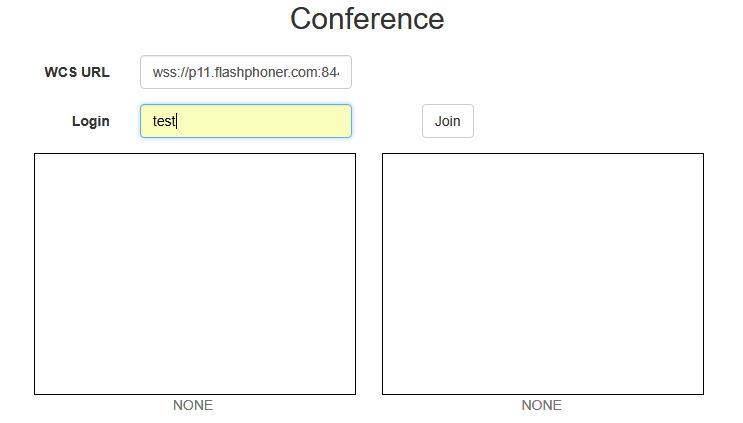
-
Click the
Joinbutton. A connection with the server is established, and you should see the correspondingESTABLISHEDlabel. The chat room is automatically created:
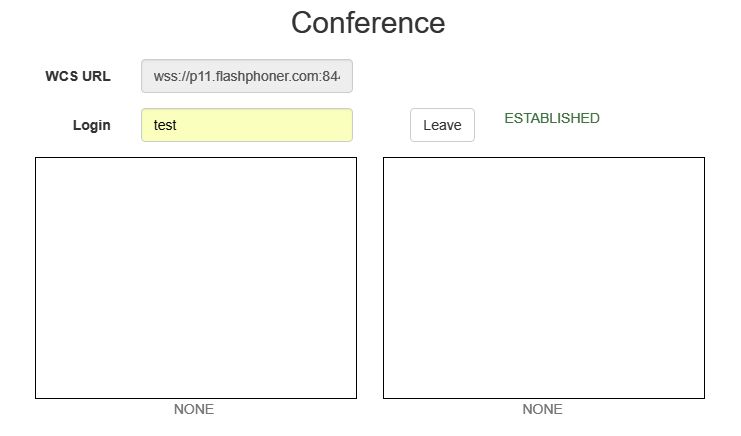
In the bottom of the screen, an image from the web camera, a text chat and a link to invite users to the room are shown:
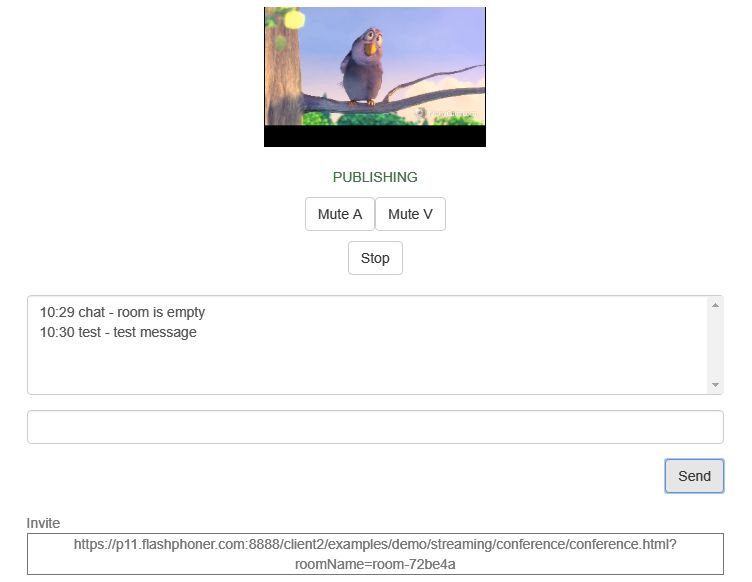
-
Copy the link to the chat room and open it in a new tab of the browser. Enter a user name other than the name of the chat room creator, for example,
test2, and click theJoinbutton. The page will display an image from the web camera of thetestparticipant (left) and from the web camera of thetest2participant (below):

-
In the text chat window of the
test2participant enter a message and clickSend:
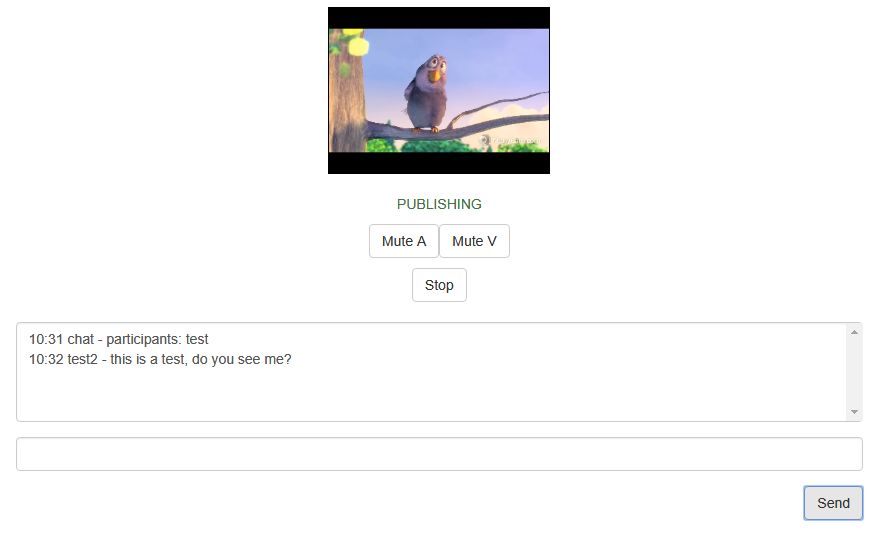
-
On the browser tab of the test participant enter an answer:
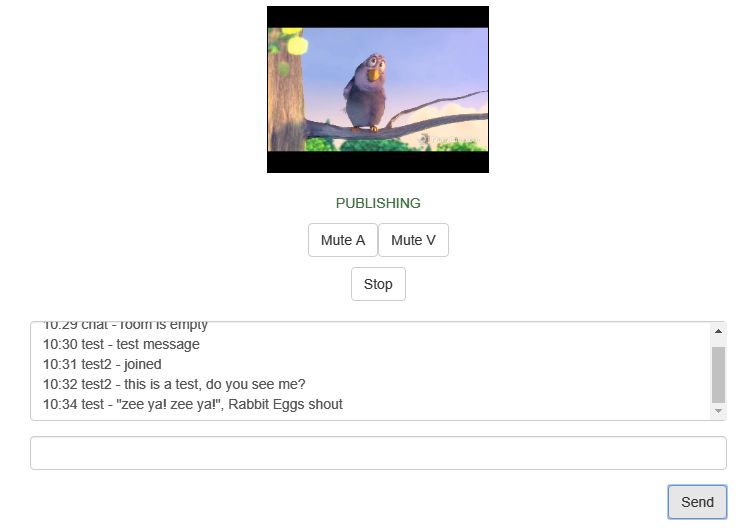
-
Make sure the answer is received:
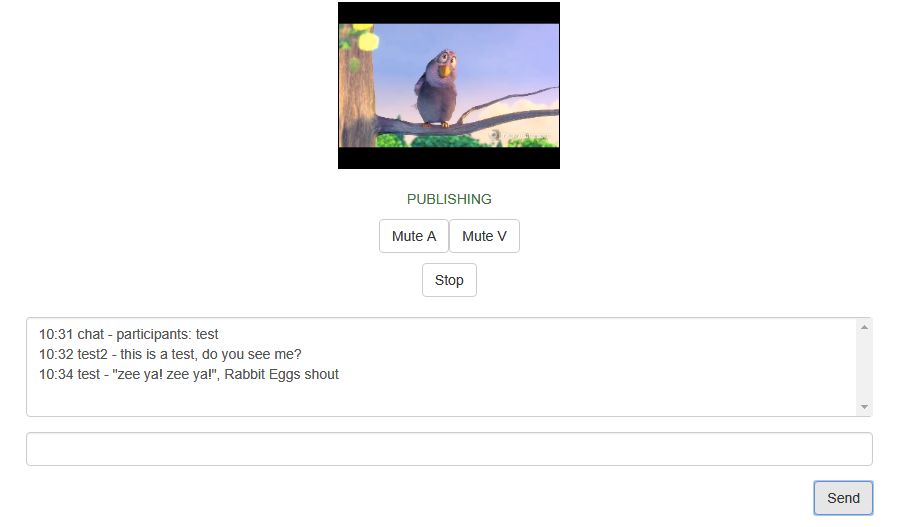
-
To leave the chat room, click the
Leavebutton
Video chat testing¶
- For the test we use:
- the demo server at
demo.flashphoner.com -
the Two Way Video Chat web application to arrange a video chat
-
Open the Two Way Video Chat web application. In the
Loginfield enter any arbitrary user name, for exampletest:

-
Click the
Joinbutton. A connection is established to the server, and the correspondingESTABLISHEDlabel is shown. The chat room is automatically created:
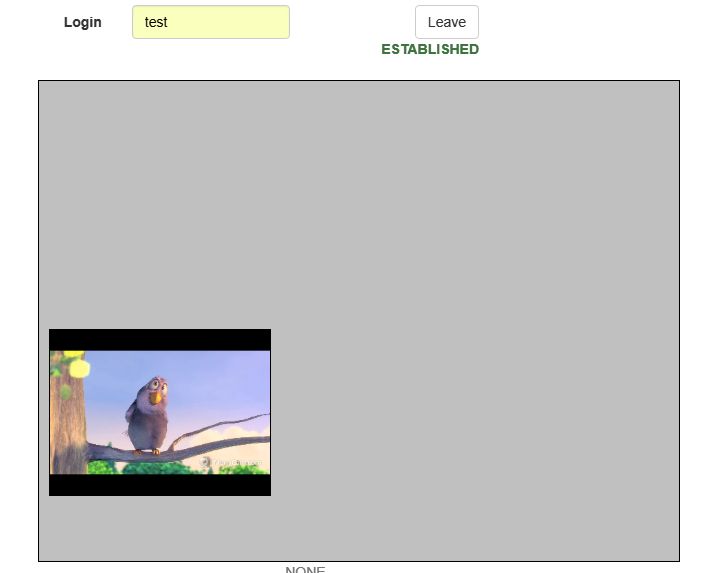
Below the screen, a text chat and a link to invite other users to the room are shown:
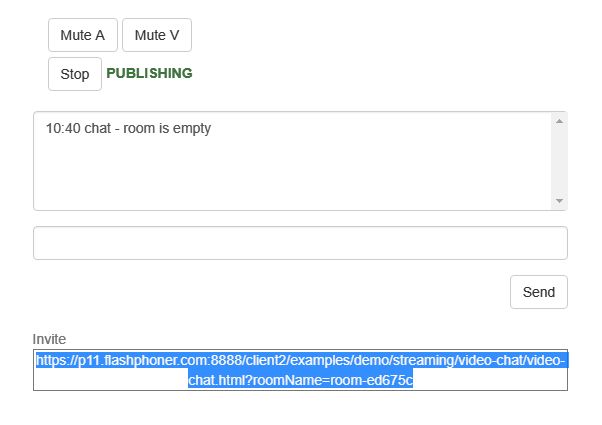
-
Copy the link to the chat room and open it in a new tab of the browser. Enter a user name other than that of the creator of the room, for example,
test2, and click theJoinbutton. The page will display a large image from the web camera of thetestuser and a smaller image from the web camera of thetest2user (in the lower left corner):
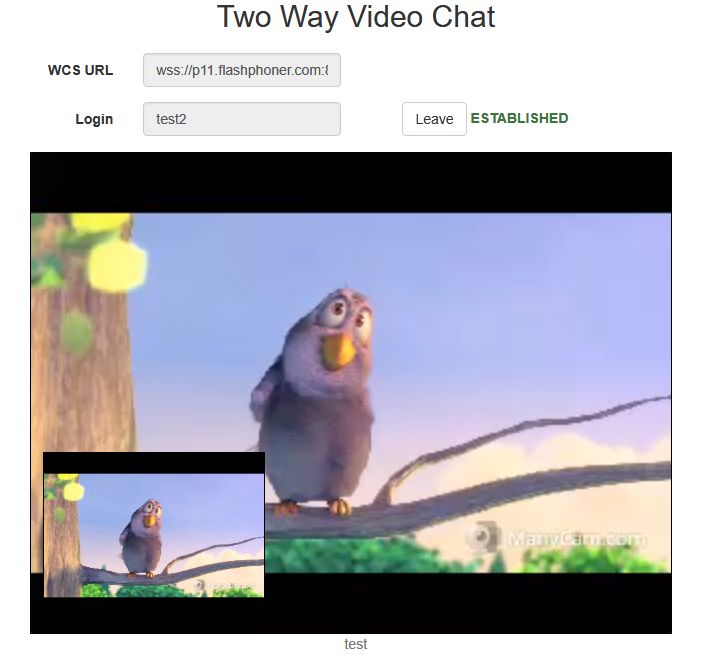
-
In the text chat box, enter a message and click the
Sendbutton:

-
On the tab of the test user enter an answer:
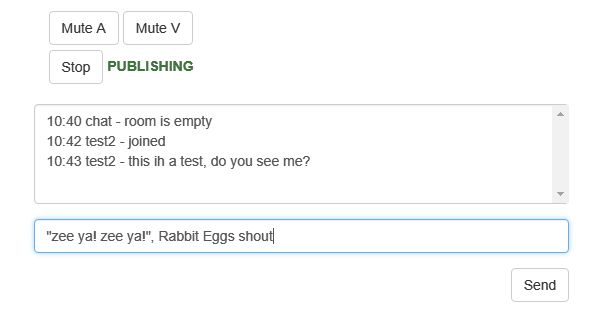
-
Make sure the answer is received:

-
To leave the chat room, click the
Leavebutton
Video conference with screen sharing testing¶
- For the test we use:
- the demo server at
demo.flashphoner.com - the Two Way Video Chat and Screen Sharing web application to organize a video conference
-
the Chrome browser
-
Open the Two Way Video Chat and Screen Sharing web application. In the
Loginfield enter any arbitrary user name, for exampletest. Click theJoinbutton. A connection is established to the server, and the correspondingESTABLISHEDlabel is displayed. The chat room is created automatically, and an image from the web camera is shown:
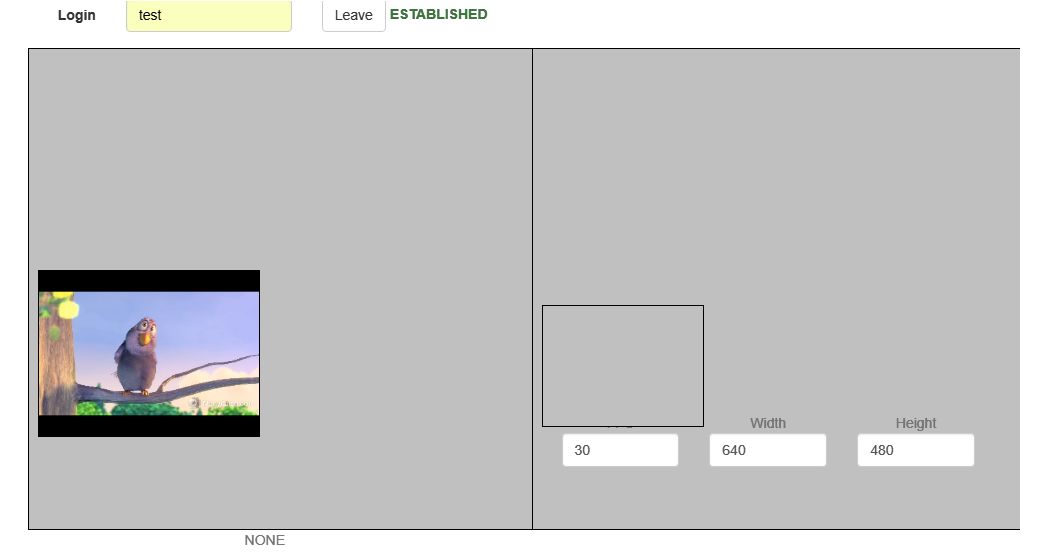
-
Copy the link to the chat room and open it in a new tab of the browser. Enter a user name different from the name of the chat room's creator, for example
test2, and click theJoinbutton. The page displays an image from the web camera:
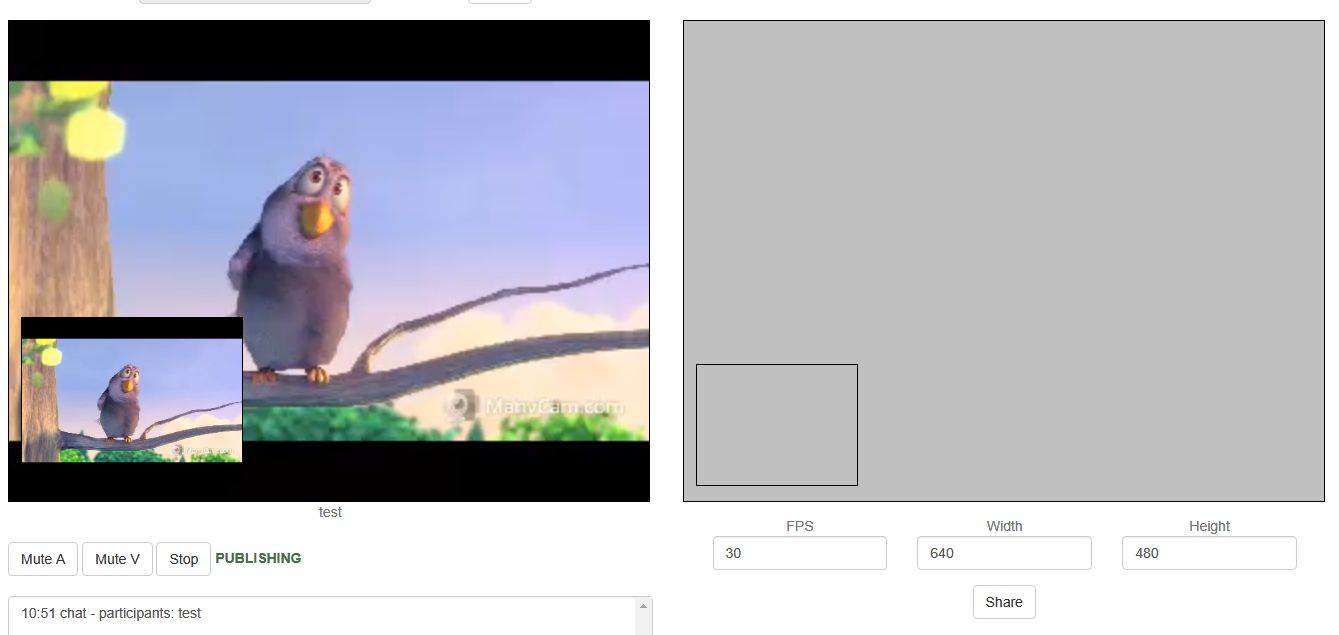
-
Click the
Sharebutton and allow the browser to gain access to your screen or to the application window:

-
On the tab of the
testuser you should see the screen or the app window you allowed the browser to access:
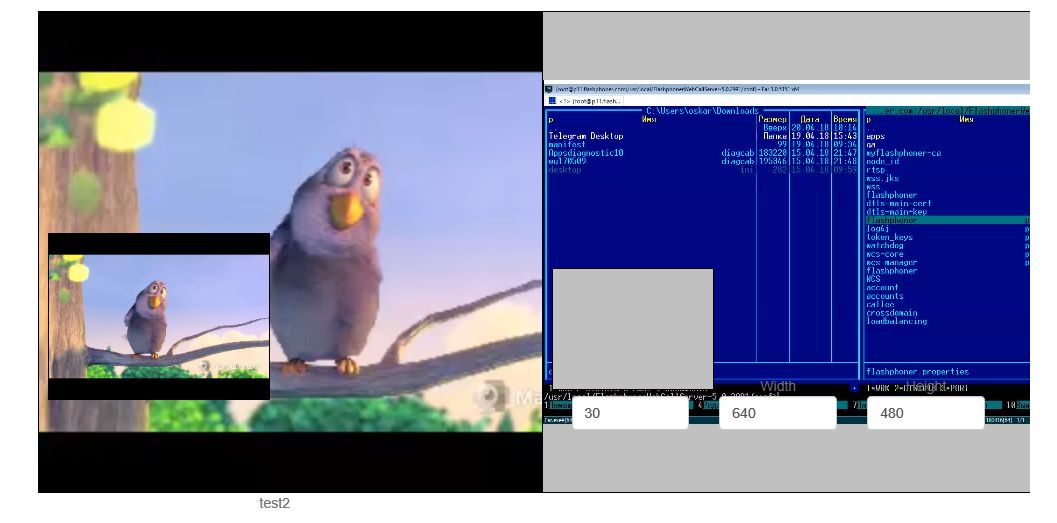
-
To leave the chat room, click the
Leavebutton
Call Flow¶
Below is the call flow when using the Conference example.
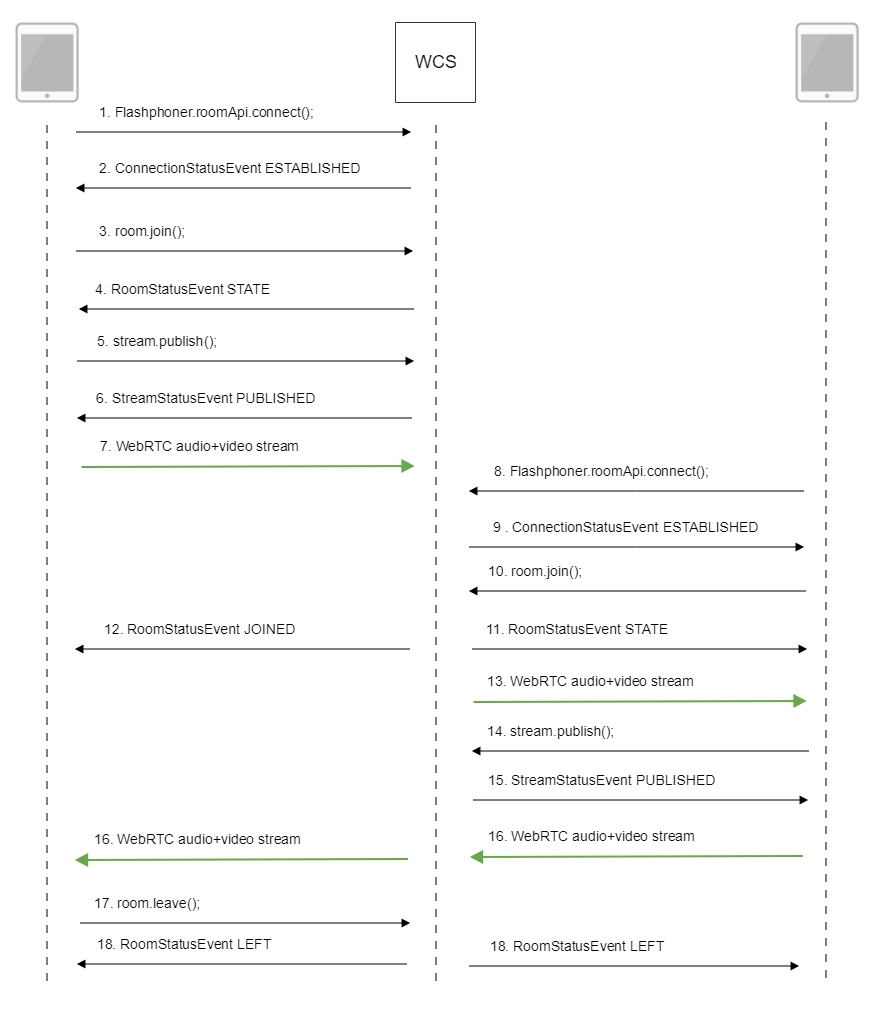
-
Participant 1 establishes a connection to the server
RoomApi.connect()code
connection = RoomApi.connect({urlServer: url, username: username}).on(SESSION_STATUS.FAILED, function(session){ setStatus('#status', session.status()); onLeft(); }).on(SESSION_STATUS.DISCONNECTED, function(session) { setStatus('#status', session.status()); onLeft(); }).on(SESSION_STATUS.ESTABLISHED, function(session) { setStatus('#status', session.status()); joinRoom(); }); -
Participant 1 receives from the server an event confirming successful connection
SESSION_STATUS.ESTABLISHEDcode
-
Participant 1 joins the chat room
Session.join()code
-
Participant 1 receives from the server an event describing the state of the room
ROOM_EVENT.STATEcode
connection.join({name: getRoomName()}).on(ROOM_EVENT.STATE, function(room){ var participants = room.getParticipants(); console.log("Current number of participants in the room: " + participants.length); if (participants.length >= _participants) { console.warn("Current room is full"); $("#failedInfo").text("Current room is full."); room.leave().then(onLeft, onLeft); return false; } setInviteAddress(room.name()); if (participants.length > 0) { var chatState = "participants: "; for (var i = 0; i < participants.length; i++) { installParticipant(participants[i]); chatState += participants[i].name(); if (i != participants.length - 1) { chatState += ","; } } addMessage("chat", chatState); } else { addMessage("chat", " room is empty"); } publishLocalMedia(room); onJoined(room); ... }); -
Participant 1 publishes the media stream
Room.publish()code
-
Participant 1 receives from the server an event confirming successful publishing of the stream
STREAM_STATUS.PUBLISHINGcode
-
Participant 1 sends the stream via WebRTC
-
Participant 2 establishes a connection to the server
-
Participant 2 receives from the server an event confirming successful connection
-
Participant 2 enters the chat room
-
Participant 2 receives from the server an event describing the state of the room
-
Participant 1 receives from the server an event informing that participant 2 has joined
ROOM_EVENT.JOINEDcode
connection.join({name: getRoomName()}).on(ROOM_EVENT.STATE, function(room){ ... }).on(ROOM_EVENT.JOINED, function(participant){ installParticipant(participant); addMessage(participant.name(), "joined"); }).on(ROOM_EVENT.LEFT, function(participant){ ... }).on(ROOM_EVENT.PUBLISHED, function(participant){ ... }).on(ROOM_EVENT.FAILED, function(room, info){ ... }).on(ROOM_EVENT.MESSAGE, function(message){ ... }); -
Participant 2 receives the stream published by participant 1
-
Participant 2 publishes the media stream
-
Participant 2 receives from the server an event confirming successful publishing of the stream
-
Participant 2 sends the stream via WebRTC, participant 1 receives this stream
-
Participant 1 leaves the chat room
Room.leave()code
-
Participants of the room receive from the server an event informing that participant 1 has left the room
ROOM_EVENT.LEFTcode
connection.join({name: getRoomName()}).on(ROOM_EVENT.STATE, function(room){ ... }).on(ROOM_EVENT.JOINED, function(participant){ ... }).on(ROOM_EVENT.LEFT, function(participant){ //remove participant removeParticipant(participant); addMessage(participant.name(), "left"); }).on(ROOM_EVENT.PUBLISHED, function(participant){ ... }).on(ROOM_EVENT.FAILED, function(room, info){ ... }).on(ROOM_EVENT.MESSAGE, function(message){ ... });
How to record streams published by room participants¶
Video streams published by room participants may be recorded. To do this, record parameter must be set to true while publishing a stream:
A stream from any participant is recorded to a separate file. The issue of record files futher processing is that they starts not at the same time.
Stream records synchronization¶
Warning
The feature is not supported sinsce build 5.2.142. Use stream mixer or multirecording instead.
To allow streams merging, room streams may be synchronized by the first stream published. To enable this feature set the following parameter in flashphoner.properties file
For example, if User1 participant started publishing stream at 00:00:10, and User2 participant did it at 00:00:55, then second participant will get 45 seconds of empty video (black screen and silence) at record beginning. So, stream record files User1.mp4 and User2.mp4 will be same in duration, and they can be merged.
Merging synchronized stream records using ffmpeg¶
Synchronized stream record files can be merged in chronological order using ffmpeg. To allow this, when stream is created, stream timeshift relative to room creation time is specified on server side. Stream record files written by this way are merged with command (two participants example)
ffmpeg -i stream1.mp4 -i stream2.mp4 -filter_complex "[0:v]pad=iw*2:ih[int];[int][1:v]overlay=W/2:0[vid];[0:a][1:a]amerge[a]" -map [vid] -map "[a]" -ac 2 -strict -2 -c:v libx264 -crf 23 -preset veryfast output.mp4
Where
stream1- first participant streamstream2- second participant stream
Room multiple streams recording to one file with subsequent mixing¶
Since WCS build 5.2.1012 and WebSDK build 2.0.190 it is possible to record all the room streams to one file, with automatic mixing after finishing a conference. To do this, a first participant should set room record option while creating a room:
In this case, all the room streams will be recorded to one file.When the room is finalized, the recording will also be stopped, and the script set in the following parameter will be automatically launched
The script will mix multiple streams recorded acoording to mixer settings defined in /usr/local/FlashphonerWebCallServer/conf/offline_mixer.json file, by default
Room recording testing¶
- For test we use:
- WCS server, for example
test1.flashphoner.com -
Conference web application example
-
Open Conference example in browser, enter participant name
Aliceand setRecordcheckbox
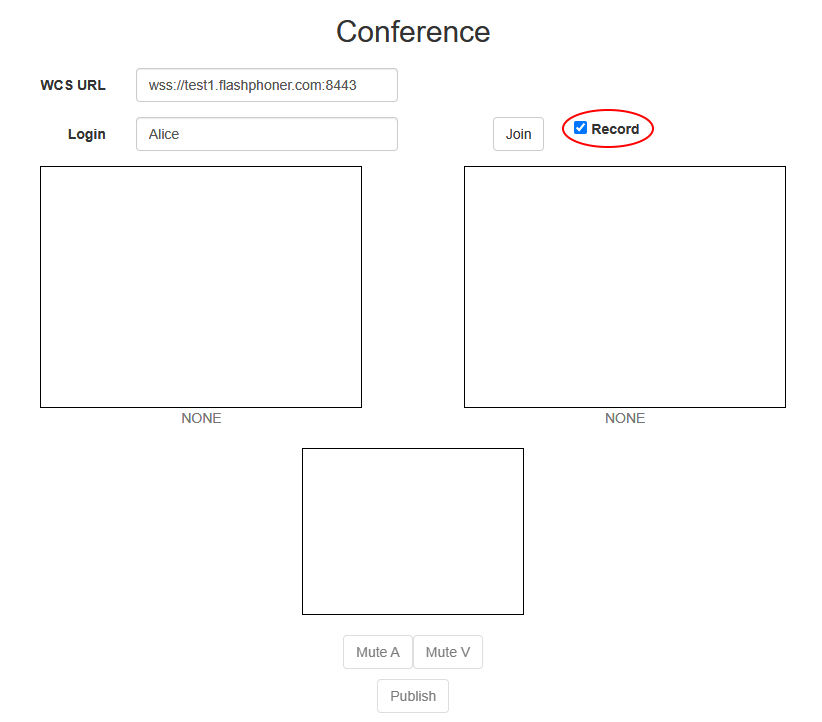
-
Click
Join. Stream publishing will start
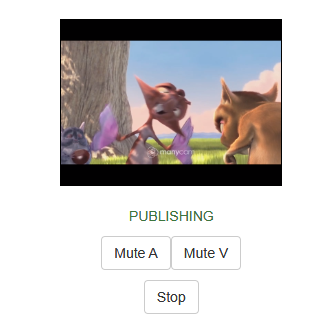
-
Open
Invitelink in another browser window
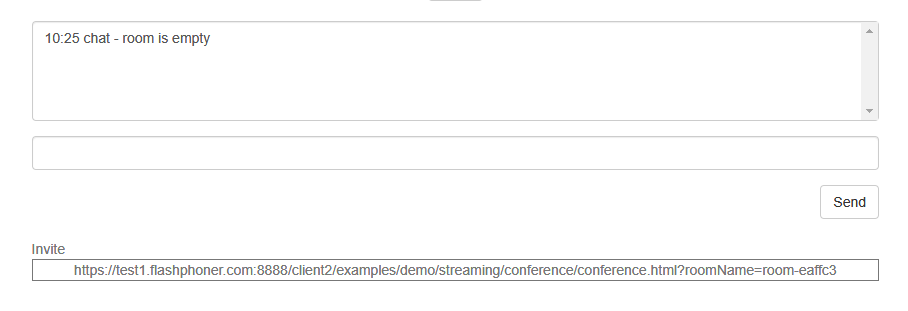
-
Enter participant name
Boband clickJoin
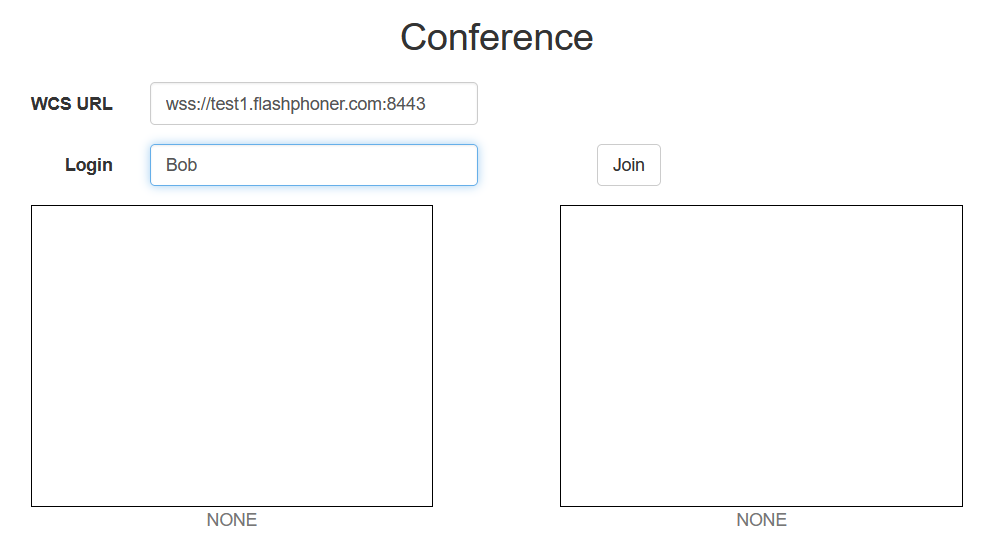
-
Bobjoined to the room
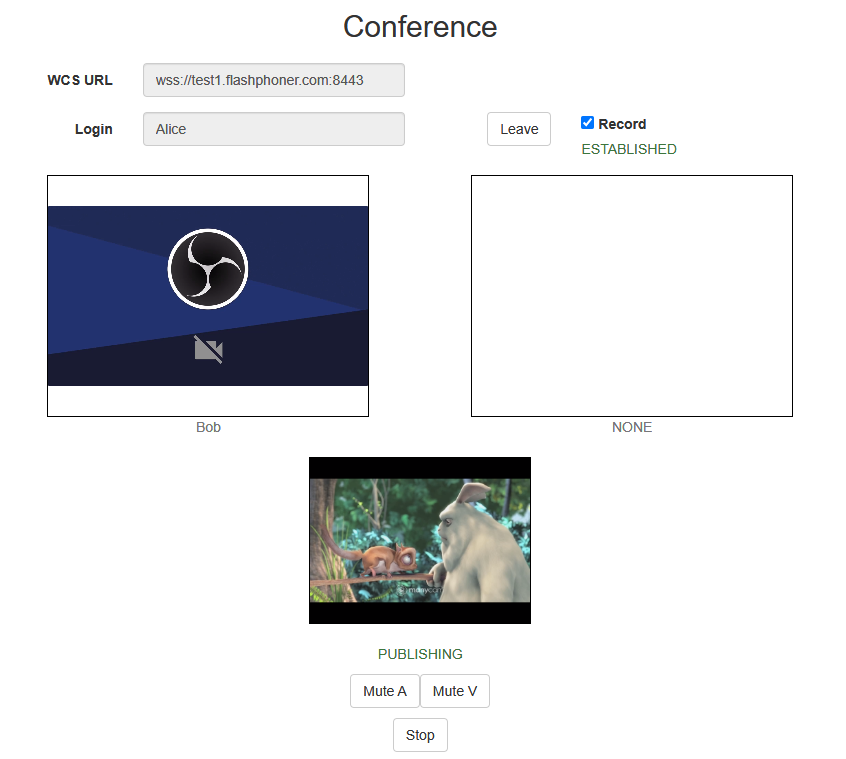
-
Click
LeaveinAliceparticipant window
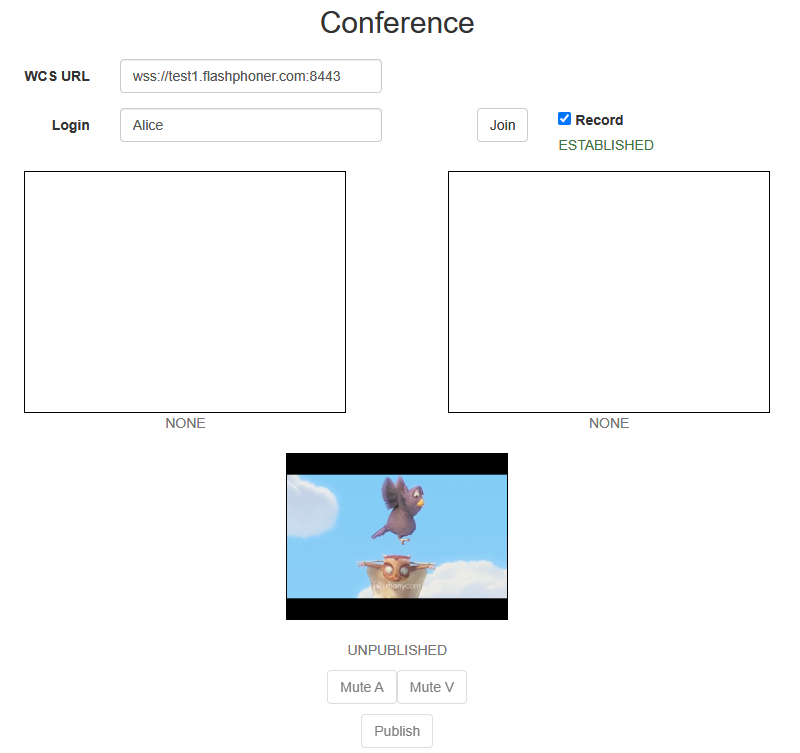
and inBobparticipant window
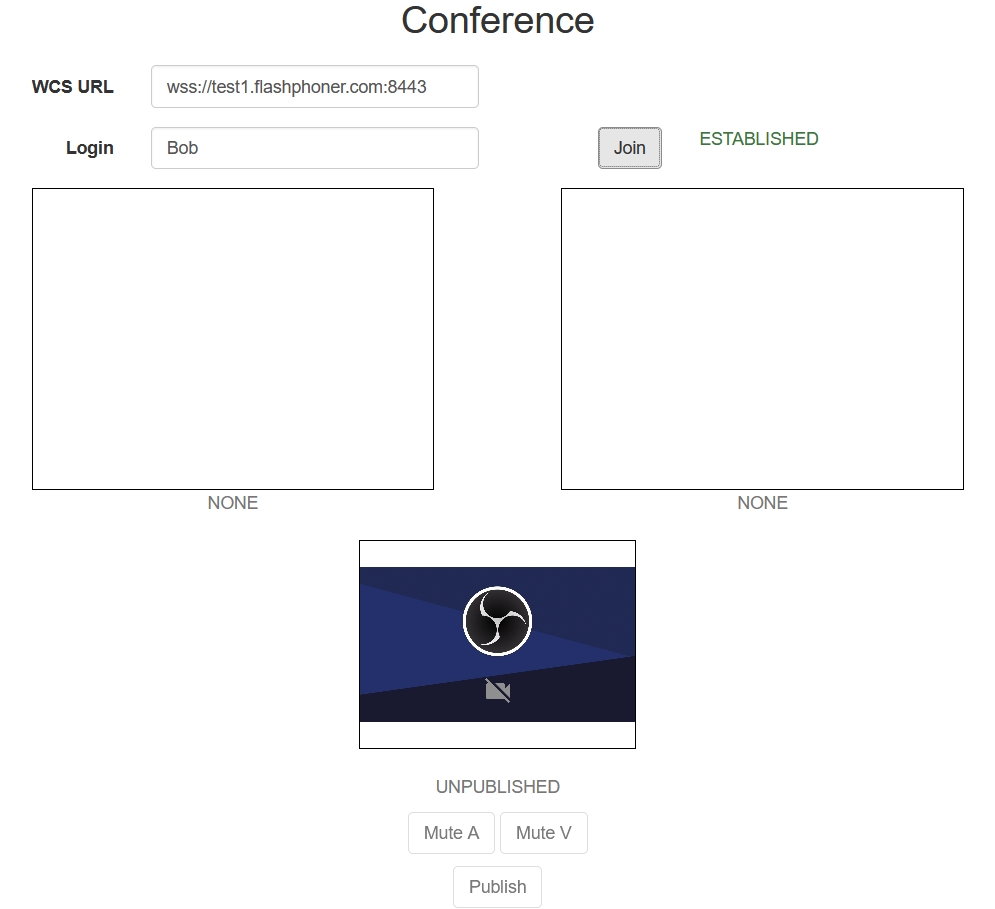
-
Recording file mixing may take a long time depending on recording length, CPU and dick I/O performance. When miximg is done, download the file from
/usr/local/FlashphonerWebCallServer/recordsfolder or open in browser by/client/recordslink
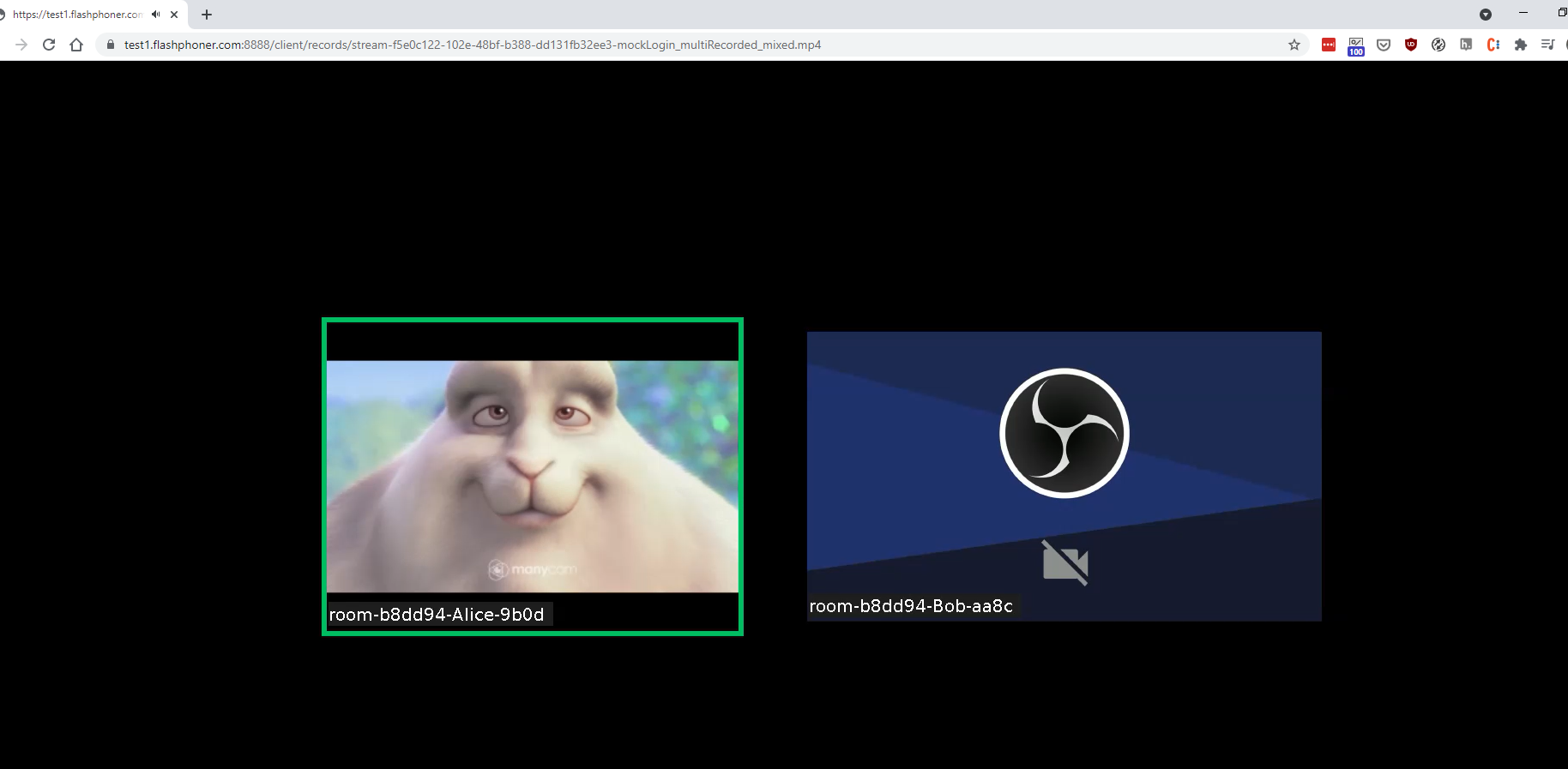
Room finalizing¶
Room exists until at least one participant is connected. When the lastparticipant calls Room.leave() function, the room is finalized.
If the last participant refreshes web page or loses server connection without calling Room.leave(), the room will be active during the time interval set by the following parameter in milliseconds
By default, the interval is 60 seconds. When time is expired, the room is finalized.
Known issues¶
1. Non-latin characters should be encoded while messaging¶
Symptoms
When message sent contains non-latin characters, they are replaced with questionmarks on receiving end
Solution
Use JavaScript functions encodeURIComponent() while sending a message
var participants = room.getParticipants();
for (var i = 0; i < participants.length; i++) {
participants[i].sendMessage(encodeURIComponent(message));
}
and decodeURIComponent() while receiving message
2. A race condition may occur when Room.leave() and then Session.join() are subsequently called too fast¶
When Session.join() and then Room.leave() are called too fast, it is possible to send join command to the server while it still handles previous leave command for this user
Symptoms
When Session.join() is called right after Room.leave(), client may receive a message
Solution
Use at least 1 second interval between Room.leave() and Session.join() subsequent calls